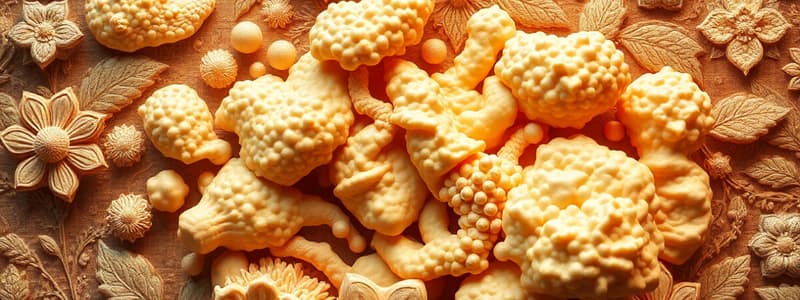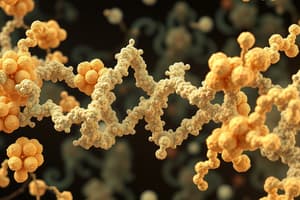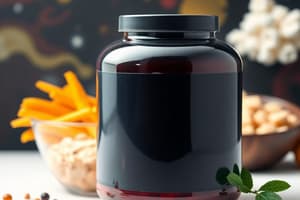Podcast
Questions and Answers
Which type of protein solely provides amino acids upon hydrolysis?
Which type of protein solely provides amino acids upon hydrolysis?
- Conjugated proteins
- Complex proteins
- Derived proteins
- Simple proteins (correct)
Which of the following proteins is classified as a lipoprotein?
Which of the following proteins is classified as a lipoprotein?
- Keratin
- Collagen
- Histone
- Hemoglobin (correct)
What is the primary structural feature that connects amino acids in a protein?
What is the primary structural feature that connects amino acids in a protein?
- Hydrogen bonds
- Peptide links (correct)
- Ionic bonds
- Disulfide bridges
Which of these proteins is a conjugated protein?
Which of these proteins is a conjugated protein?
Which of the following is NOT a biological function of proteins?
Which of the following is NOT a biological function of proteins?
What type of protein consists of only amino acids and does not include other biochemical components?
What type of protein consists of only amino acids and does not include other biochemical components?
What are the terminal groups called at either end of a polypeptide chain?
What are the terminal groups called at either end of a polypeptide chain?
In which type of protein classification would you find keratin and collagen?
In which type of protein classification would you find keratin and collagen?
What distinguishes conjugated proteins from simple proteins?
What distinguishes conjugated proteins from simple proteins?
Which of the following is an example of an immunoglobulin?
Which of the following is an example of an immunoglobulin?
What is the primary function of transferrin in the body?
What is the primary function of transferrin in the body?
Which of the following correctly describes ferritin?
Which of the following correctly describes ferritin?
Which type of protein primarily participates in the transport of oxygen within the body?
Which type of protein primarily participates in the transport of oxygen within the body?
What differentiates primary protein derivatives from secondary protein derivatives?
What differentiates primary protein derivatives from secondary protein derivatives?
What does coagulated albumin represent?
What does coagulated albumin represent?
Which of the following best describes nucleoproteins in the context of their components?
Which of the following best describes nucleoproteins in the context of their components?
What characterizes the action of hydrolyzing agents on proteins?
What characterizes the action of hydrolyzing agents on proteins?
Which of the following is an example of a secondary protein derivative?
Which of the following is an example of a secondary protein derivative?
What is the role of FAD/FMN in flavoproteins?
What is the role of FAD/FMN in flavoproteins?
What is the effect of heat or acid on proteins?
What is the effect of heat or acid on proteins?
What is a key characteristic of gelatin in relation to dietary protein value?
What is a key characteristic of gelatin in relation to dietary protein value?
Which of the following statements about coagulation of proteins is correct?
Which of the following statements about coagulation of proteins is correct?
Which type of protein is characterized as lacking one or more essential amino acids?
Which type of protein is characterized as lacking one or more essential amino acids?
What non-protein part is associated with glycoproteins?
What non-protein part is associated with glycoproteins?
Which of the following proteins is a metalloprotein?
Which of the following proteins is a metalloprotein?
What is the primary role of lipoproteins in the body?
What is the primary role of lipoproteins in the body?
The caseinogen is classified as which type of protein?
The caseinogen is classified as which type of protein?
Which characteristic is NOT true about serum globulin?
Which characteristic is NOT true about serum globulin?
What distinguishes high biological value proteins from low biological value proteins?
What distinguishes high biological value proteins from low biological value proteins?
Which of the following is considered a function of antibodies?
Which of the following is considered a function of antibodies?
Flashcards
Protein Definition
Protein Definition
Organic complex nitrogenous compounds formed from C, H, O, N (sometimes S), combining amino acids into polypeptide chains.
Protein Structure
Protein Structure
Polypeptide chains of amino acids linked by peptide bonds (-CO-NH-), with a C-terminal end and an N-terminal end.
Peptide Bond
Peptide Bond
The link between amino acids in proteins, formed from a carbonyl group and an amine group.
Simple Protein
Simple Protein
Signup and view all the flashcards
Protein Classification
Protein Classification
Signup and view all the flashcards
Conjugated Proteins
Conjugated Proteins
Signup and view all the flashcards
Derived Proteins
Derived Proteins
Signup and view all the flashcards
Protein Roles (Enzymes)
Protein Roles (Enzymes)
Signup and view all the flashcards
Protein Roles (Hormones)
Protein Roles (Hormones)
Signup and view all the flashcards
Protein Importance
Protein Importance
Signup and view all the flashcards
Coagulation
Coagulation
Signup and view all the flashcards
Gelatin source
Gelatin source
Signup and view all the flashcards
Gelatin property (digestion)
Gelatin property (digestion)
Signup and view all the flashcards
Gelatin nutritional value
Gelatin nutritional value
Signup and view all the flashcards
High biological value protein
High biological value protein
Signup and view all the flashcards
Low biological value protein
Low biological value protein
Signup and view all the flashcards
Glycoprotein example
Glycoprotein example
Signup and view all the flashcards
Lipoprotein function
Lipoprotein function
Signup and view all the flashcards
Phosphoprotein example
Phosphoprotein example
Signup and view all the flashcards
Transferrin
Transferrin
Signup and view all the flashcards
Ferritin
Ferritin
Signup and view all the flashcards
Insulin
Insulin
Signup and view all the flashcards
Chromoprotein
Chromoprotein
Signup and view all the flashcards
Hemoglobin
Hemoglobin
Signup and view all the flashcards
Myoglobin
Myoglobin
Signup and view all the flashcards
Flavoprotein
Flavoprotein
Signup and view all the flashcards
Nucleoprotein
Nucleoprotein
Signup and view all the flashcards
Primary Protein Derivatives
Primary Protein Derivatives
Signup and view all the flashcards
Secondary Protein Derivatives
Secondary Protein Derivatives
Signup and view all the flashcards
Study Notes
Protein Types
- Proteins are complex nitrogenous organic compounds.
- They are formed from carbon (C), hydrogen (H), oxygen (O), nitrogen (N), and sometimes sulfur (S).
- Proteins are polymers of amino acids linked together by peptide bonds (-CO-NH-).
- The ends of a polypeptide chain are:
- C-terminal: COOH group at one end.
- N-terminal: NH2 group at the other end.
Biological Importance of Proteins
- Enzymes: Catalyze biochemical reactions.
- Hormones (protein hormones): Regulate bodily functions.
- Plasma proteins: Contribute to blood functions.
- Immunoglobulins (antibodies): Defend against pathogens.
- Receptors: Receive and transmit signals.
- Hemoglobin: Transports oxygen.
- Lipoproteins: Transport lipids.
- Supporting structures: (e.g., cartilage, bone, skin, hair).
Classification of Proteins
- Simple proteins: Composed solely of amino acids.
- Examples: Albumin, globulin, histone, protamine, glutelin, gliadin, and albuminoids (scleroproteins). Sub-types such as keratin and collagen are examples of scleroproteins.
- Albumin is coagulated by heat. Globulin is not.
- Conjugated (compound) proteins: Contain a non-protein component (prosthetic group).
- Sub-types (examples and functions):
- Glycoproteins: Carbohydrate component
- Lipoproteins: Lipid component
- Phosphoproteins: Phosphoric acid component
- Metalloproteins: Metal component (e.g., copper, iron, zinc)
- Chromoproteins: Pigment component (e.g., hemoglobin)
- Nucleoproteins: Nucleic acid component (e.g., ribosomes)
- Sub-types (examples and functions):
- Derived proteins: Products of simple or conjugated protein denaturation or hydrolysis.
- Sub-types such as proteoses, peptones, peptides, and amino acids are secondary and derived proteins, denoting progressive hydrolysis. They are characterized by a loss of structural elements and hence differences in molecular weight.
Gelatin
- Derived from collagen by boiling and cooling.
- Easily digested.
- Not a complete protein (low biological value) as it lacks some essential amino acids such as tryptophan.
Biological Value of Proteins
- High biological value proteins: Contain all essential amino acids (e.g., casein in milk, albumin, globulin).
- Low biological value proteins: Lack one or more essential amino acids (e.g., gelatin, gliadin, vegetable proteins).
Studying That Suits You
Use AI to generate personalized quizzes and flashcards to suit your learning preferences.




